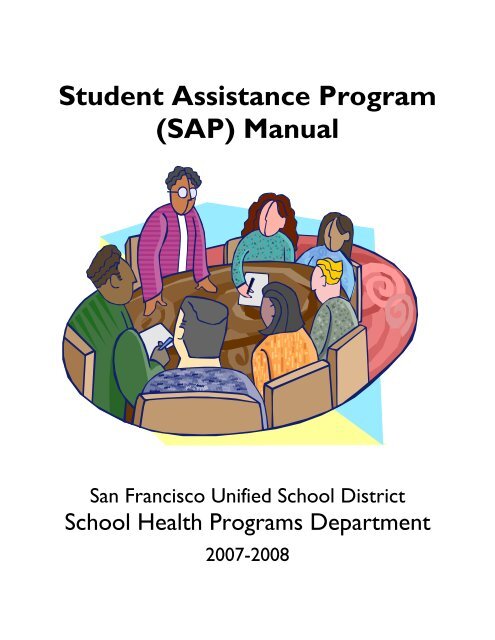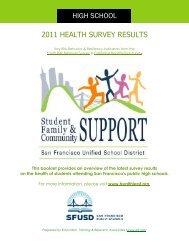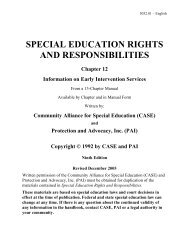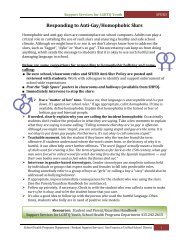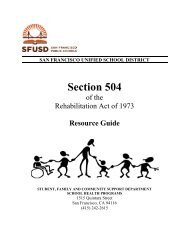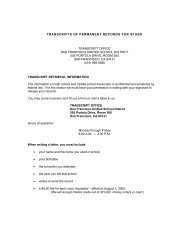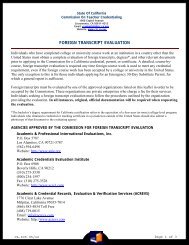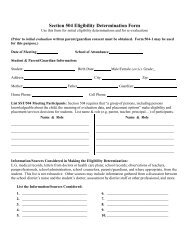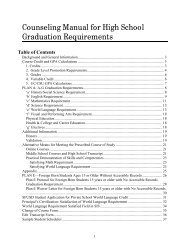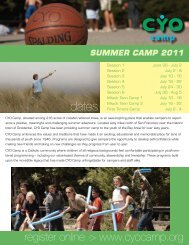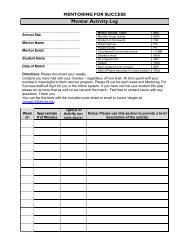SAP - SFUSD School Health Programs
SAP - SFUSD School Health Programs
SAP - SFUSD School Health Programs
- No tags were found...
You also want an ePaper? Increase the reach of your titles
YUMPU automatically turns print PDFs into web optimized ePapers that Google loves.
Student Assistance Program(<strong>SAP</strong>) ManualSan Francisco Unified <strong>School</strong> District<strong>School</strong> <strong>Health</strong> <strong>Programs</strong> Department2007-2008
Student Assistance Program (<strong>SAP</strong>)Table of ContentsWhat is a Student Assistance Program (<strong>SAP</strong>)? 2<strong>SAP</strong>/SST: A Brief Comparison 3How to Initiate a Student Assistance Program (<strong>SAP</strong>) 4-5Request for Assistance (1.0) form 6<strong>SAP</strong> Meeting Roles and Responsibilities 7<strong>SAP</strong> Flowchart 8<strong>SAP</strong> Interventions 9-10<strong>SAP</strong> Follow-Up Practices 11<strong>SAP</strong> Best Practices Checklist 12-13What is Facilitation? 14Facilitator Self-Assessment Checklist 15Sample <strong>SAP</strong> Meeting Agenda #1 16Sample <strong>SAP</strong> Meeting Agenda #2 17-18Sample <strong>SAP</strong> Meeting Agenda #3 19Sample <strong>SAP</strong> Action Plan 20Sample <strong>SAP</strong> Case Management/Follow-up Form 21Sample Parent/Teacher Conference Form 22<strong>SFUSD</strong> Oath of Confidentiality 23<strong>SFUSD</strong> <strong>School</strong> <strong>Health</strong> <strong>Programs</strong> Department – <strong>SAP</strong> Manual August 2007 1
What is a Student Assistance Program (<strong>SAP</strong>)?The Student Assistance Program (<strong>SAP</strong>) is a “learning support” umbrella structurethat brings together all support service providers at a school site. The <strong>SAP</strong> focuseson referred students, and coordinates respective programs and services to promotetheir academic success. The <strong>SAP</strong> provides early identification, assessment,referral, support, and service coordination for students experiencing academic,attendance, behavior/social, or health problems that impact on school success. Inaddition, school-wide issues are identified and addressed. At the elementary level it hasbeen most commonly named a Coordinated Services Team (CST) or Care Team.The <strong>SAP</strong> process includes:1) Early Identification: Students withacademic, attendance, behavior/social,health issues are referred to the <strong>SAP</strong>team.2) Assessment: <strong>SAP</strong> team gathersinformation regarding the studentreferred and identifies the student’sstrengths and needs.3) Planning and Support: <strong>SAP</strong> teamidentifies and links students withschool and community basedinterventions and resources.4) Service Coordination: Identified <strong>SAP</strong>team member follows a student’sprogress with recommendedinterventions and resources.5) <strong>School</strong>-wide Assessment & ProgramDevelopment: Identifying, linking anddeveloping resources—within andoutside the school community—thatreflect the broad issues/trends identifiedby the team to support student success(e.g. - support groups, mentoring,positive behavior support, structuredbefore-school and recess activities).Who is on the <strong>SAP</strong> team?• Administrator/Principal• Attendance Liaison• Dean or Head Counselor• Elementary or Middle <strong>School</strong> Advisors• ExCEL After <strong>School</strong> Program SiteCoordinator (ASP)• Instructional Reform Facilitator• Learning Support Professional (LSP)and/or Wellness Coordinator (WC)• Outreach Coordinator• Parent Liaison• Representative of Community BasedOrganizations (CBOs) regularly on-site• <strong>School</strong> Counselor• <strong>School</strong> District Nurse (SDN)• <strong>School</strong> Psychologist• Site Nutrition Coordinator (SNC)• Special Education Representative (e.g.Resource Specialist -RSP teacher)• Others, as recommended by TeamA <strong>SAP</strong> can address students who:• exhibit behavioral/mental health issues• face significant illness or disability• have chronic attendance problems• have difficulty with academics• have family or peer issues• suffer from trauma associated withexposure to violence• use/abuse substances• are experiencing sexual health, sexualorientation, pregnancy issues<strong>SFUSD</strong> <strong>School</strong> <strong>Health</strong> <strong>Programs</strong> Department – <strong>SAP</strong> Manual August 2007 2
<strong>SAP</strong> and SST: A Brief ComparisonThe Student Assistance Program (<strong>SAP</strong>) is a “learning support” umbrella structure that bringstogether all support service providers at a school site. The <strong>SAP</strong> develops and monitors programsand resources that enhance prevention and intervention efforts contributing to student success.The <strong>SAP</strong> focuses on referred students, and coordinates respective programs and services topromote their academic success. At the elementary level it has been most commonly named aCoordinated Services Team (CST) or Care Team.The Student Success Team (SST) is a problem solving and coordinating structure that assistsindividual students, families and teachers to seek positive solutions for maximizing studentpotential. The SST focuses in-depth on one student at a time, and invites the parent/caregiverand student to participate in finding solutions.<strong>SAP</strong>Who: Site administrators, learning support staffand “support service” providers (SeeWhat is a Student Assistance Program(<strong>SAP</strong>)? (pg. 2)Meeting for staff only, no parents or students.Focus: 1) Multiple students with: academic,behavior, attendance, andhealth/mental health concerns.2) Link students with site/communityresources.3) Develop and coordinate schoolwideprograms reflective ofstudents’ needs.How: 1) Students are ‘case managed’ by theteam and followed by one teammember to assist with access toresources and supports for positiveprogress.2) Develop and implement educationalsupport programs based onidentified needs.When: Weekly meetings of the team.SSTWho: Parent/caregiver, student, teachers,administrator, service/supportproviders at school site, CBOsworking with the student and family,special education representative, andSST Coordinator.<strong>School</strong> psychologist is invited to assist as aconsultant, if and when available.Focus: 1) One identified student: academic,attendance, behavior, and/orhealth/mental health concerns.2) Multidimensional action plandeveloped.3) Follow-up meeting involving allstakeholders to review the actionplan.How: 1) Team explores strategies to developan intervention plan involving home,classroom, school, and community.2) Designated “case manager” helpsto oversee implementation of theintervention plan/action items.3) Spec. Ed. Assessment may beconsidered an option, followingdocumentation of interventions andstudent’s response to thoseInterventions.When: Scheduled meetings called by SSTcoordinator accommodating schedulesof stakeholders.<strong>SFUSD</strong> <strong>School</strong> <strong>Health</strong> <strong>Programs</strong> Department – <strong>SAP</strong> Manual August 2007 3
How to Initiate a Student Assistance Program(<strong>SAP</strong>)1. Enlist support from the site administrator to implement an effective<strong>SAP</strong>• Commitment/leadership from the site administrator is the key to a successful <strong>SAP</strong>• Meet with the Principal or Assistant Principal to confirm support for developing aneffective <strong>SAP</strong>. Provide administrator with background information about <strong>SAP</strong>sand the benefits of student support servicesUseful documents: What is a Student Assistance Program? (pg. 2)<strong>SAP</strong> and SST: A Brief Comparison (pg. 3)<strong>SAP</strong> Flow Chart (pg. 8)• Identify <strong>SAP</strong> team members, including who will serve as the <strong>SAP</strong>Coordinator/Facilitator. See <strong>SAP</strong> Meeting Roles and Responsibilities (pg. 7)• Identify a meeting space that is convenient, private, and available on aweekly basis• Agree on a referral process. Use the <strong>SAP</strong> Flowchart (pg. 8) as a guide2. Raise staff awareness about <strong>SAP</strong>s / Get staff commitment• Introduce the <strong>SAP</strong> model to staff at faculty meetings, grade level meetingsdepartment meetings and/or other appropriate venues using the followingsuggested activities:a) Describe benefits to staff of having an <strong>SAP</strong> program, e.g. one-stop referralprocess; provision of services to students with severe needs, as well asthose at mid-risk; support and follow-through that is coordinatedb) Present a case from start to finish; use <strong>SAP</strong> Flow Chart (pg. 8)c) Review criteria for referral and the referral process, including introductionof the Request for Assistance (1.0) form (pg. 6)• Distribute a memo and/or flyer introducing the <strong>SAP</strong> to all staff• Identify allies within the staff and utilize their support to engage others3. Establish a regular meeting time and structure/agenda for <strong>SAP</strong>meetings• When scheduling meetings, consider days/times when most or all support staffare on site (e.g. Learning Support Professional, <strong>School</strong> District Nurse, <strong>School</strong>Psychologist, After <strong>School</strong> Program Site Coordinator, Parent Liaison,Attendance Liaison, etc.)• All team members commit to the regularly scheduled meetings and anyroles/responsibilities assigned (e.g. coordinator/facilitator, time keeper, recorder,case manager). See <strong>SAP</strong> Meeting Roles and Responsibilities (pg. 6) for aclarification of roles.<strong>SFUSD</strong> <strong>School</strong> <strong>Health</strong> <strong>Programs</strong> Department – <strong>SAP</strong> Manual August 2007 4
How to Initiate a Student Assistance Program(<strong>SAP</strong>)4. Collaborate with teachers at grade level planning meetings, duringtheir prep time or other available times to help identify and referstudents to the <strong>SAP</strong>. (At the elementary level, consider the benefits of aClassroom SST to systematically identify and refer students.)5. Provide feedback to referral sources, monitor action plans andensure ongoing evaluation of the effectiveness of the <strong>SAP</strong>meetings. Utilize the <strong>SAP</strong> Best Practices Check List (pg. 12-13)6. Address school-wide trends, issues and concerns by developingschool-based programs and linkages with community resources tomeet students’ needs and improve their success at school.• Map current resources on site provided by school staff or through partnershipswith community-based organizations (CBOs)• Based on students’ needs and trends identified through the <strong>SAP</strong> process, developprograms to enhance school climate and improve student achievement (e.g.,groups, mentoring, tutoring, positive behavior incentive program, create studentinvolvement/leadership opportunities, etc.<strong>SFUSD</strong> <strong>School</strong> <strong>Health</strong> <strong>Programs</strong> Department – <strong>SAP</strong> Manual August 2007 5
Referral ToStudent Assistance Program (<strong>SAP</strong>)Student Success Team (SST)Request for Assistance (1.0)San Francisco Unified <strong>School</strong> District<strong>School</strong> Site: _________________________--CONFIDENTIAL: please do not leave out for others to read--Student: (Last, First) Grade GenderParent/Caregiver Home Language Telephone NumberMFDOB Ethnicity HO#Name of person Making Request Your Title Classroom or Telephone ExtensionAttach photo ofstudent if available1. Student’s Strengths 2. Your Concerns about Student 3. Prior InterventionsAble to problem solveArticulates feelings/needsAsks for helpAttentive in classCooperates with othersDemonstrates sense of humorEnjoys mathEnjoys readingFollows instructionsHelpful to othersListens wellMakes/maintains friendshipsNegotiates/compromisesParticipates in classRegular AttendanceOther: ______________________________________________________________________________________________________Please check and provide additional details: Academic__________________________________________________________________________ Attendance__________________________________________________________________________ Emotional or Behavioral__________________________________________________________________________ Family/home__________________________________________________________________________ Physical <strong>Health</strong>/Medical__________________________________________________________________________ Other__________________________________________________________________________ Behavioral interventions Classroom modifications Instructional modifications Met with student Offered tutoring/after-school program Spoken to/met with parent/caregiver Other:_______________________Please describe your interventionsincluding length of time tried._____________________________________________________________________________________________________________________________Response to Intervention (RTI):(Attach data across 12 weeks)____________________________________________________________________________________================================== Complete if student is referred to SST=================================4. Student Profile Section (<strong>SAP</strong>/Counselor/SST Team to complete):STAR 9 (Two previous yrs): Year Reading Lang Math Support services student is currently receiving:After-<strong>School</strong> Prog GATE ELD/ELLTutoring Mentoring Peer Resources IEP 504 Plan Foster Youth Services (FYS)Mental <strong>Health</strong> Physical <strong>Health</strong> Other:<strong>Health</strong> Most recent Physical Exam: ___________________IZ Status: Complete Incomplete: ____________________Chronic health conditions?Screening Date Status –Pass/Fail FUrequired?VisionHearing5. Date family notified re: referral to SST: Results:==================================Feedback to Referring Person===================================Date Referral ProcessedPrimary Contact PersonAction Items Planned1.Who Will Follow-up2.3.DISTRIBUTION: ORIGINAL: <strong>SAP</strong> Binder COPIES: Primary Contact Person & Referral Source<strong>SFUSD</strong> <strong>School</strong> <strong>Health</strong> <strong>Programs</strong> Department – <strong>SAP</strong> Manual August 2007 6
Student Assistance Program (<strong>SAP</strong>)Meeting Roles and ResponsibilitiesAll <strong>SAP</strong> team members are active contributors. In addition, the process defines special rolesthat some members of the team must fill to achieve the greatest positive outcome. Meetingroles may be assigned by the coordinator/facilitator, or team members may select to sign upfor a particular role. It is important to ensure that during any meeting each team member’s roleis clearly defined before the meeting begins and then maintained throughout that meeting.Coordinator/Facilitator (Permanent position - designated administrator in collaboration with astudent support services professional, e.g. LSP, WC, Counselor, SDN)• Based on school issues and <strong>SAP</strong> referrals received, create a meeting agenda anddistribute to all <strong>SAP</strong> team members at, or prior to, the meeting• Bring <strong>SAP</strong> binder to meeting• Ensure that meeting roles are filled (recorder, timekeeper, etc.)• Begin the meeting, designate an amount of time for each agenda item, allow time forfollow-up discussion, and facilitate the meeting• Facilitate but do not dominate the discussion and help to elicit the most helpfulcontributions of the group and most important, keep a positive tone at the meeting• Clarify action items, identify next steps, and ensure that a case manager is assigned toeach student discussed• Make sure all referral forms, meeting agendas and notes are filed in the <strong>SAP</strong> binderRecorder/Note Taker (may rotate)• Make sure to record day and time of the meeting and who attended• Capture key information and clearly delineate all action items (what, who, and by when)• Use a laptop and/or a standard meeting notes template to take notes• Provide a copy of the <strong>SAP</strong> meeting notes to all <strong>SAP</strong> team members in a timely mannerTimekeeper (may rotate)• Assist the Coordinator/Facilitator in starting the meeting on time• Keep track of time allotted for specific topic discussions and remind the facilitator whendiscussion time is over• Provide Coordinator/Facilitator with a five-minute warning toward the end of the meetingTeam Member• An effective team member is a positive contributor to the work of the team. Members comeprepared with information about the students discussed and school-wide issues/programs.Contributions that address difficult problem areas are positive, looking at constructivesolutions, rather than characterizing, blaming or stereotyping. Interventions are linked tothe students’ strengths and programs developed are linked to students’ nee<strong>SFUSD</strong> <strong>School</strong> <strong>Health</strong> <strong>Programs</strong> Department – <strong>SAP</strong> Manual August 2007 7
Student Assistance Program (<strong>SAP</strong>) Flowchartconsults withSupport Staff• Counselor• Dean• LSP• Nurse• Parent Liaison• <strong>School</strong> - 8 - Psychologist• Wellness Coordinator• otherTeacher/Staff Member/Parentis concerned about a student because of:• academics• attendance• behavior/emotional issues• healthInitial Interventions are AttemptedMay Include:• Student conference• Parent conference• Class change• Tutoring• RTI• Etc.if student is a danger to themself or others (behaving unsafely)DO NOT WAIT!Go directly to administratorfor appropriate actions andconsequences.Consult w/ the following asneeded:• Police• Child Crisis• Child Protective Services• LSP/ Wellness Coordinator• <strong>School</strong> District Nurse• Mental <strong>Health</strong> CBOsIf initial interventions are unsuccessful or ongoing monitoring is needed, then:Teacher/Staff Member/ Parent/StudentFills out Request for Assistance Form 1.0and gives to <strong>SAP</strong> CoordinatorInitial crisis resolved<strong>SAP</strong> Coordinator Reviews and Prepares the Following:(may delegate tasks to other <strong>SAP</strong> members as necessary)• 1.0 Request for Assistance Form• Attendance Record• Cum Folder• Grade Report/Report Card/Progress Reports• <strong>SAP</strong> Meeting AgendaInform referring party of<strong>SAP</strong> Meeting and Action PlanSART MeetingSST Meeting<strong>SAP</strong> Team Meeting• held weeklyFollow-up• Review action plan• Review studentprogress• Brainstorm additionalResponsibilites of <strong>SAP</strong> Team• Review student history• Brainstorm interventions,including referrals to inschoolservices, CBOs, etc.• Develop Action Plan• Appoint “Case Manager” orcontact person to ensureaction plan is implemented• Set date for follow-up• Analyze student trends/ needsfor program development<strong>SFUSD</strong> <strong>School</strong> <strong>Health</strong> <strong>Programs</strong> Department – <strong>SAP</strong> Manual August 2007 8
Student Assistance Program (<strong>SAP</strong>) Interventions<strong>SAP</strong> Interventions: Student• Conduct a more thorough assessment of the student (e.g. review cum folder, meetwith teachers, observe student in class)• Meet with the student. Get to know him/her.• Refer student to an after-school program• Initiate a counseling referral• Place in a peer or adult mentoring program• Have the student come up with his/her own academic and/or behavior goals• Work with student on a behavior contract• Provide the opportunity for frequent “check-ins”, perhaps by several adults• Refer to an appropriate student support group• Don’t wait for trouble to call home, call with good news about the student• Request that RSP teacher work with students who are academically “at-risk”until further assessment can be done• Refer for a SST<strong>SAP</strong> Interventions: Parent• Contact parent/caregiver – ask about family strengths and concerns regarding student• Schedule a parent/teacher conference(See Sample Parent/Teacher Conference Form, pg. 22)• Create a ‘parent space/room’ at the school• Provide presentations that appeal to parents (e.g. workshops such as “How to talkto your kid so they will listen”, “How to help your child with homework”, “Helping your 6 thgrader adjust to middle school”, “Making the most of a parent-teacher conference”, etc.)<strong>SAP</strong> Interventions: Classroom• Explicitly teach and review classroom expectations, including transitions• Provide reinforcement/feedback that is specific and unique to students• Provide a 4 to1 ratio of positive reinforcement to corrective action to promote expectedclassroom behavior• Catch students being good• Utilize a “peace table” or “chill-out” space• Use a multi-sensory approach (e.g. using math manipulatives in addition to verbal andwritten instructions)• Incorporate physical/movement activities into academic blocks to provide stressreduction/tension release• Assign classroom responsibilities/class jobs that build confidence and self-esteem• Physically arrange classroom consistent with level of structure needed• Give students choice/options of activities/tasks to increase sense of controland engagement in the classroom• Encourage team work to accommodate a variety of learning styles (e.g. a studentwho is a good note taker can provide them to targeted students)• Enhance selection of high interest books for students• Break down assignments into smaller sections(Note: It is sometimes helpful for <strong>SAP</strong> team members to work one-on-one with teachers to support classroomchanges necessary for improved student outcomes.)<strong>SFUSD</strong> <strong>School</strong> <strong>Health</strong> <strong>Programs</strong> Department – <strong>SAP</strong> Manual August 2007 9
Student Assistance Program (<strong>SAP</strong>) Interventions(continued)<strong>SAP</strong> Interventions: <strong>School</strong> Wide• Start a mentoring program• Start a peer mediators/peer conflict managers program• Increase meaningful involvement and participation in school activities, clubs, and events• Develop a peer-tutoring program• Enhance student and campus safety/security (e.g. conflict resolution programs)• Help create commitment for a school-wide behavior system (e.g. Best Behavior,Caring <strong>School</strong> Community, Tribes, CHAMPs, IRISE, Omega)• Give leadership opportunities to students (e.g. crossing guard, office monitoring,conflict resolution mediator)• Establish a drop-in homework center.• Support transitions: home, school, and classroom, after-school, vacations• Post school rules/norms in classrooms, halls, restrooms, cafeteria and yard• Start a positive behavior incentive program (e.g. “caught being good” tickets)• Provide opportunities for public recognition (e.g. attendance, positive behavior,“Golden Trash Can” award for cleanest room)• Collaborate with After <strong>School</strong> Program to create a “seamless day”• Start a Breakfast Club to reward attendance• Promote health & nutrition education & activities<strong>SAP</strong> Interventions: Community• Invite CBO speakers to your <strong>SAP</strong> to describe programs and referral procedure• Plan and host a health fair• Invite your local police (e.g. <strong>School</strong> Resource Officer, SRO) or fire fighters to shoothoops/play on the yard with students• Collect information on resources and services in the community, including providinginformation on services that are no-cost, low-cost or based on a sliding scale tofamilies and staff• Connect with community centers and city Parks and Recreation facilities• Implement business and community mentoring• Establish a central location to place community resource information• Enlist the resources of the faith community• Enlist San Francisco <strong>School</strong> Volunteers<strong>SFUSD</strong> <strong>School</strong> <strong>Health</strong> <strong>Programs</strong> Department – <strong>SAP</strong> Manual August 2007 10
Student Assistance Program (<strong>SAP</strong>) Follow-Up PracticesThe interventions, actions and modifications discussed at a <strong>SAP</strong> meeting are only as goodas the follow-up practices that ensure their implementation.Steps for follow-up:1) Case ManagementA case manager or “contact person” is assigned to each student discussed at the <strong>SAP</strong>. Thecase manager’s role is to ensure that the action plan items are implemented. Case managertasks may include:• Meeting with the student and with the teacher regarding the action plan• Making phone calls and/or sending reminder notes to team members regarding action items• Contacting parents/caregivers regarding the action plan and to enlist their support• Setting up meetings on-site with service providers to help bridge the student/family with a particularprogram or agency2) DocumentationAction items, or “Action Plans”, are documented for each student and monitored by the <strong>SAP</strong>.Regardless or the specific method or form used, it is important to document action items/plansand follow-up measures. A <strong>SAP</strong> binder is a useful tool to maintain a consistent and organizedrecord. Also, see sample <strong>SAP</strong> agendas, action plan and follow-up form on pages 16-21. The<strong>SAP</strong> binder should be kept in a confidential location, but known and available to teammembers.3) Feedback to the Referral SourceThe case manager, or another designated person, provides the referral source with feedbackin a timely manner after the initial <strong>SAP</strong> meeting. It is often beneficial to involve the referralsource in some ownership of the plan, particularly classroom strategies, modifications andadaptations, especially if the person had not been involved in the actual <strong>SAP</strong> meeting thatwas held.4) Student/Family ParticipationWorking with students and parents/caregivers to commit to the plan and to undertake actionson their own behalf is an important part of the follow-up. The student and parent/caregiverhave to feel that they have some control over their own goals and plans, and that school staffare their allies, rather than the ones who have all the control.5) Follow-Up DiscussionEvery student discussed at the <strong>SAP</strong> is reviewed regularly. Many <strong>SAP</strong> coordinators find ithelpful to include a follow-up section on the agenda. During follow-up discussion, the casemanager/contact person updates the <strong>SAP</strong> on the status of the student’s action plan.Additional interventions may be initiated depending on the student’s progress, such as referralfor a Student Success Team (SST) or Student Attendance Review Team (SART) meeting, orconnection with other school site or community-based resources.<strong>SFUSD</strong> <strong>School</strong> <strong>Health</strong> <strong>Programs</strong> Department – <strong>SAP</strong> Manual August 2007 11
Student Assistance Program (<strong>SAP</strong>)Best Practices ChecklistPlease rate each item using the following scale:1= poor 2 = fair/OK 3 = good 4 = excellentPre <strong>SAP</strong> MeetingThere is a regular weekly meeting timeA consistent location is established for the meetingThere is a referral process in place that uses the Request for Referral 1.0Staff is aware of <strong>SAP</strong> purpose and there is “buy-in”Each <strong>SAP</strong> member is committed to providing follow-up activitiesAgendas are distributed at or prior to the meetingThere is a designated <strong>SAP</strong> coordinator/facilitatorStudent referrals are elicited from multiple sources, including review of school-wide data:Teachers/Staff Transition Forms DF/U Lists Focal Students SART ListRetention Lists Students Lacking Mandated <strong>Health</strong> Screenings Foster Youth Services (FYS) CensusDuring <strong>SAP</strong> MeetingAt the beginning of the year, Oath of Confidentiality is signed by each memberTeam members are consistent in attending the entire meetingPlease check those that attend:AdministratorOutreach CoordinatorAttendance LiaisonParent LiaisonCBO Representative(s)<strong>School</strong> CounselorDean/Head Counselor<strong>School</strong> District NurseElementary/Middle <strong>School</strong> Advisor<strong>School</strong> PsychologistExCEL ASPSite Nutrition CoordinatorInstruction Reform FacilitatorSpecial Education RepresentativeLSP or Wellness CoordinatorOthers: __________________Meetings start and end on timeThere is efficient use of meeting time (e.g. several students are discussed at eachmeeting, team member discussions remain “on topic”)There are designated staff who fulfill roles during the meeting (e.g. facilitator, note taker,timekeeper, etc.)Action items from previous meeting(s) are reviewedMembers participate and share their respective knowledgeStudent information is available at the meeting (e.g. cum folder, attendance records)The team is able to solve problems and develop action plans for studentsAll team members volunteer to, or are assigned to, follow-up on action itemsThe team discusses program issues/needs of the site to identify service gaps and developnew programs (e.g. mentoring, tutoring)Post <strong>SAP</strong> MeetingMeeting notes are distributed after the meetingAll Request for Assistance 1.0 Forms, <strong>SAP</strong> Agendas, and meeting notes are kept by <strong>SAP</strong>Coordinator/Facilitator in a <strong>SAP</strong> binderAction items are monitored by the <strong>SAP</strong> coordinator/facilitator and designated case managerAction items are completed by assigned/designated team memberFeedback is provided to the referral source in a timely manner<strong>SFUSD</strong> <strong>School</strong> <strong>Health</strong> <strong>Programs</strong> Department – <strong>SAP</strong> Manual August 2007 12
Student Assistance Program (<strong>SAP</strong>)Best Practices Checklist (continued)What are the strengths of your <strong>SAP</strong>?________________________________________________________________________________________________________________________________________________________________________________________________________________________________________________________________________What are some improvements that need to be made?________________________________________________________________________________________________________________________________________________________________________________________________________________________________________________________________________For those schools without an <strong>SAP</strong>, please list the first steps that you think need tobe taken in order to start a team. What will be some of the challenges? Who areother support staff that you need to engage in order to start an effective <strong>SAP</strong>?________________________________________________________________________________________________________________________________________________________________________________________________________________________________________________________________________<strong>SFUSD</strong> <strong>School</strong> <strong>Health</strong> <strong>Programs</strong> Department – <strong>SAP</strong> Manual August 2007 13
What is Facilitation?Facilitation is a way of providing leadership without taking the reins. Your job as a facilitator is toget others to assume responsibility and take the lead.Core Practices of Facilitators:• Stay neutral on content: Focus on the process. This doesn’t mean that you can’t offersuggestions; it just means that you shouldn’t impose your opinions on the topic to thegroup.• Listen Actively: Look people in the eye, use positive body language, paraphrase.• Ask Questions: Test assumptions, invite participation, and gather information.• Paraphrase to Clarify: (“Are you saying”, “What I’m hearing you say is…”)• Synthesize Ideas: Get people to comment on what others are saying and build on theirthoughts.• Identify a Scribe: Create a visual action plan/ ‘to do’ list to keep group on task.• Stay on Track: Set a time line for the meeting and appoint a time keeper. Use a parkinglot to record ideas that are important but not on topic. Label situations if they aresidetracks.• Give and Receive Feedback: Call on people that seem to be disengaged from theprocess; ask members how they feel the meeting is going or if you are making progress;regularly evaluate the effectiveness of the meeting by eliciting feedback from groupmembers.• Test Assumptions: Bring assumptions out into the open, clarify them, and challengethem.• Collect Ideas: Keep track of emerging ideas and final decisions. Notes should reflectwhat people actually said and not your interpretation of what was said (see Identify aScribe).• Summarize Clearly: Summarize to revive a discussion that has come to a halt or toend a discussion when things seem to be wrapping up.• Identify Next Steps: Identify action items, who is responsible and when tasks are tobe accomplished.Source: Facilitating With Ease, Ingrid Bens © 2000<strong>SFUSD</strong> <strong>School</strong> <strong>Health</strong> <strong>Programs</strong> Department – <strong>SAP</strong> Manual August 2007 14
Facilitator Self-Assessment ChecklistBehaviors that Help__ listens actively__ maintains eye contact__ helps identify needs__ gets buy-in__ surfaces concerns__ defines issues__ brings everyone intothe discussion__ uses good body languageand intonation__ paraphrases continuously__ provides feedback__ accepts and uses feedback__ checks time and pace__ provides useful feedback__ monitors and adjusts the process__ asks relevant, probing questions__ keeps an open attitude__ stays neutral__ offers suggestions__ is optimistic and positive__ manages conflict well__ takes a problem-solving approach__ stays focused on process__ ping-pongs ideas around__ makes accurate notes thatreflect the discussion__ looks calm and pleasant__ is flexible about changingthe approach used__ skillfully summarizeswhat is said__ knows when to stopBehaviors that Hinder__ oblivious to group needs__ no follow-up on concerns__ poor listening__ strays into content__ loses track of key ideas__ makes poor notes__ ignores conflicts__ provides no alternatives forstructuring the discussion__ gets defensive__ puts down people__ no paraphrasing__ lets a few people dominate__ never asks "How are we doing?"__ tries to be the center of attention__ lets the group get sidetracked__ projects a poor image__ uses negative or sarcastic tone__ talks too much__ doesn’t know when to stopAdditional Observations:______________________________________________________________________________________________________________________________________________________Source: Facilitating With Ease, Ingrid Bens © 2000<strong>SFUSD</strong> <strong>School</strong> <strong>Health</strong> <strong>Programs</strong> Department – <strong>SAP</strong> Manual August 2007 15
Sample <strong>SAP</strong> Meeting Agenda #1Date: ____ / ____ / ____Attendees: ___________________________________________NEW <strong>SAP</strong> REFERRALS:Student Grade Ref Teacher/GL CounselorReason for Referral/ConcernsContactPersonComplete <strong>SAP</strong> Action Plan for each student (see Sample Action Plan, page 20)FOLLOW-UP ON ACTIVE <strong>SAP</strong> STUDENTS:Student Grade Ref Teacher/GL CounselorReason forReferral/ConcernsUpdates & InterventionsContactPersonReview <strong>SAP</strong> Action Plan for each studentSCHOOL-WIDE ISSUES & PROGRAMS:Issue or Program Updates/Actions ContactPersonNext Meeting Date: __________________Adapted from John O’Connell High <strong>School</strong><strong>SFUSD</strong> <strong>School</strong> <strong>Health</strong> <strong>Programs</strong> Department – <strong>SAP</strong> Manual August 2007 16
Sample <strong>SAP</strong> Meeting Agenda #2Sample content in italics.Date: ________________Team members present: ________________________________1. <strong>School</strong> Attendance Review Team (SART)• Review identified students (see attendance log)___________________ ______________________________________ ______________________________________ ___________________• Student Advisor (logistics & incentives); Parent Liaison (follow-up)• Dog tags and certificates for Sep. 06 perfect attendance breakfast on 10/10/062. SST & IEP Meetings• 10/10 – 7:30 am ____________ 3:00 pm ____________• 10/11 – 7:45 am ____________ 3:00 pm ____________• 10/17 – 3:00 pm ____________ 3:45 pm ____________• <strong>School</strong> psych. assessments: completed ____________;underway ____________3. <strong>School</strong>-wide Wellness/Planning & Coordination of <strong>Programs</strong>• Mandarin Immersion• Mental <strong>Health</strong> Services & Student Intervention Team (SB1895 Program)• Omega Program (Group with Dr. Marshall will be on Tuesdays)• Mentor Program (mentor recruitment underway)• College Bound / Career Awareness Program (planning underway)• <strong>School</strong>-wide behavior (remind staff to use recognition slips to address common area behavior)• “Discipline Gap” – define the issue. Strategies: 1) AA mentors; 2) continue staff discussion;3) address concerns for identified students; 4) 10/14 lecture by Hilliard4. Parent Liaison Report• PTA• Parent Wellness/Education Speakers Series (parents to generate list of ideas)• E-script/fundraising (make this a PTA priority)5. <strong>School</strong> District Nurse Report• Consider “Jump Rope for Heart Program”• Status of vision screening follow-up6. ExCEL After <strong>School</strong> Program Report• Enrollment at: ______• “Lights On” October 12 th• Behavior concerns: ______________________________________(Case Management on next page)<strong>SFUSD</strong> <strong>School</strong> <strong>Health</strong> <strong>Programs</strong> Department – <strong>SAP</strong> Manual August 2007 17
Sample <strong>SAP</strong> Meeting Agenda #2 (continued)7. Case ManagementStudent History New info/updatesA.C.New kinder. IEP/ADHD withfetal alcohol/drug exposureand Hx of child abuse until age3.J.T.Family Mosaic. Has schoolbasedtherapist; meds given atschool.Has therapist at Westside Ajani;Afternoon para support; putting togetherbehavior/support plan; IEP 10/11/06Recd. Dr. consent to provide meds onsite. Contacted therapist and casemanager about behavior/med. Rxn?S.P. Family moved to Oakland Transferring to East Bay school, when?D.R.CPS case still active. Has new Court date on 9/12. SST held. Behaviortherapist.support plan 10/10/06E.W.Grief/loss issues. Therapy withintern last year.Moved to Valencia Gardens; refer toYMCA therapist; need to f/u with motherfor med. examD.W.Grief/loss issues. Therapy withintern last year.Moved to Valencia Gardens; referred toYMCA site-based therapist.J.L.Foster care. Has therapist. Mentor and behavior plan this yearIEP.Z.S. Emotional/behavioral issues. Assigned to intern therapist; mentorprogramA.S. IEP; ADHD; retained 2 nd gr. Met with mother; completed consent forIntern/therapyH.F.Attendance/late arrival issues.Behavior concernsLSP & teacher have spoken with mother;YMCA therapy underway; SST 10/11/06G. F. Academic concerns, gets Scheduled SST 10/17/06frustrated.E.U.Learning and attendance Has glasses; testing underwayissuesK.H.Transfer from T.I. Medical and Referred to Intern; mentor programbehavior issuesD.M. Behavior/emotional concerns CPS here today; mother told teacher shewould like help; started YMCA therapy;mother connected with Instituto by CPSA.M. Significant behavior concerns On SST listS.W.Mo. Hx of substance abuse;attendance concernsHome visits x2; attendance has improved;referred to InternAdapted from Starr King Elementary <strong>School</strong><strong>SFUSD</strong> <strong>School</strong> <strong>Health</strong> <strong>Programs</strong> Department – <strong>SAP</strong> Manual August 2007 18
Sample <strong>SAP</strong> Meeting Agenda #3Note: This sample agenda format allows the note-taker to incorporate member attendance, notes about students, new and previously referred, and discussion about schoolwideissues. If notes are recorded electronically, the note-taker can sort by student’s last name, by grade, etc.(Sample content in italics)Meeting Date: _1-7-07_COMPLETED (note “COMPLETED” when distributed to members as final copy) Chair: _______________________Team members: (names BOLD if present) _________________________________________________________________________________________Guests: Excused: (members who notified coordinator in advance, of absence)----------check all that apply---------------# N or Student (Last, First) Gr Ref by Acad Attend Beh/E <strong>Health</strong> Other CP #1 CP #2 ASP NotesRmot1. R 7 Smith X X (outclass)X X AB 3 Ds, 4 Fs; no Us; SST #1: Dec. __, 06; case discussion at HACon 1/4/07. Case conf 1/5/07 with Fam Mosaic.2. N 8 Jones X CD NP 1 D; no Us. Now living w dad, who has rules and sets limits. Isan RSP stu. Needs IEP Addendum.3. R 8 Ramirez X X EF 3 Ds, 1 F; no Us SST #1 10/11/06. Jones created Behav checklistthat stu likes. SST #2 to be sched. Move to Smith?4. R 8 Chin X X GH QR 3 Ds, 1 F; 2 Us SST to be sched. Pending counselor w Beacon orWellness Ctr5. R 8 Fierro X X JK 6 Fs; 5 Us. Was suspended 1/3/07. To have Cslg Conf on 1/9/07at 11:30 AM6. R 8 Jackson X X LM ST 2 Ds, 4 Fs; 2 Us SST to be sched by Jones. In “Top Ten” list.Mom has knee disability.Glossary: N = newly referred in school year; R = student was referred this year already; CP = contact person; ASP = after-school programAgenda/Minutes:• We only have 101 days remaining this school year to make a difference for our students• Grade level meetings: teachers would like to have admin presence at first half or last half of these meetings…• Beacon: Starr announced that Vanessa xxxxx will be joining us as of Feb 07.• PACT: needs parents to complete Intake forms for their CBO• Admin update: Complete documentation of services for students receiving Care Team services by end of January• <strong>Health</strong> update: Hearing/Vision follow-up being done with assistance from site support sub.• Good news: xxx will return to full-time status at GRD starting Jan. 29.• <strong>School</strong> will look at changing breakfast and elective schedules as of second semester. Mtg at 4:15 PM today for staff input.Adapted from Gloria R. Davis Academy<strong>SFUSD</strong> <strong>School</strong> <strong>Health</strong> <strong>Programs</strong> Department – <strong>SAP</strong> Manual August 2007 19
Sample <strong>SAP</strong> Action PlanStudent’s Name: _______________________________________ Date: _________________Teacher/Referring Staff: ________________________________ Room: ________________Case Manager/Contact Person: __________________________________________________What?(Action items) Academic counseling After <strong>School</strong> Program Group (e.g. anger management, social skills, grief , etc) <strong>Health</strong> review & referrals Home visit Mentoring One-to-one counseling/check-ins Parent Teacher Conference (documented) Progress Report (daily or weekly) Tutoring Student Attendance Review Team (SART) Student Success Team (SST) Other: (further interventions based on student’s needs) _______________________________ _______________________________ _______________________________ _______________________________ _______________________________ _______________________________Who?(Person responsible, e.g.teacher, LSP, SDN, etc.)When?(Date to initiate orcomplete action item) Copy to <strong>SAP</strong> Binder Copy to Case Manager/Contact Person Copy to Teacher / Referral Source<strong>SFUSD</strong> <strong>School</strong> <strong>Health</strong> <strong>Programs</strong> Department – <strong>SAP</strong> Manual August 2007 20
Sample <strong>SAP</strong> Case Management/Follow-up Form<strong>School</strong>: ___________________________________________Updated: ____ / ____ / ____Note: This form is maintained by the <strong>SAP</strong> Coordinator to document and monitor student concerns, action plans and progress.(Sample content in italics)StudentName(Grade/Teacher)Jane Doe(6 th /Jones)Initial<strong>SAP</strong>DateConcerns Interventions Follow-upDate09/05/06 Behavior • Schedule IEPaddendum toincludebehavior goal– Ms. C• Classroomobservation– Ms. B• Enroll in boysgroup- Mr. SUpdates09/26/06 • Mom hassignedconsent forcounselingw/ Mr. RAdditionalInterventions• IEPscheduledfor 9/29/06to addbehaviorplanResultFollowupasneededJohn Doe(6 th /Dun)09/05/06 Behavior • Family Mtg.w/ mom re:behavior- Mr. W• AB3632eligible-ismom takinghim? – Ms. C09/26/06 • Ms. C metw/mom• Ms. C toconductdailybehaviorchecks andreport tomom• MomsignedpermissionSoutheastto serve asAB3632provider –willreceivecounselingFollowupasneededJessicaDoe(6 th /Hop)09/12/06 EmotionalBehavior• Counselingand HV-Mr. S• Possibility ofnocturnalasthma-Ms. B10/03/06 • Currentlyseeing Mr.S forindividualcounseling• Continuew/counseling• MonitorBehaviorFollowupasneededAdapted from Willie L. Brown Jr. College Preparatory Academy<strong>SFUSD</strong> <strong>School</strong> <strong>Health</strong> <strong>Programs</strong> Department – <strong>SAP</strong> Manual August 2007 21
Sample Parent / Teacher Conference FormNote: Parent/Teacher conferences may be used as an intervention prior to referral to the <strong>SAP</strong> or recommended as partof a <strong>SAP</strong> action plan. This sample form offers a guide through a documented conference discussion.<strong>School</strong> Name: _______________________________________Date: ________________Student: ____________________________________________Parent/Caregiver: ____________________________________Grade: ________________Language: _____________Parent Contact Information (telephone #): _____________________________________________Teacher(s) participating in conference (name and subject taught):1) ________________________________________________________________________________2) _______________________________________________________________________________3) _______________________________________________________________________________Strengths? Concerns? Ideas for parent/student? Asks for help Attends class every day Comes prepared withmaterials Comes to class on time Completes homework Does well on tests Gets along with otherstudents Has positive attitude Is respectful towards adults Listens wellStudent needs to: Attend school every day Be on time to class Bring all materials Remain seated during class Complete class work Participate appropriately Communicate respectfully Help others as needed Be positive towardslearning Pay attention, focus 8-10 hrs of sleep; alarm clock Attend After-<strong>School</strong> tutorials Check homework log daily Clean up backpack/locker Daily Progress Report Enroll in an after-school program Get health check-up & follow up Get phone #s of study buddies <strong>Health</strong>y breakfast & lunch daily Obtain counseling: academic/social/emotional Obtain/meet with adult mentor Participates in class Complete homework Reward small improvements Solves problems Other: Student Attendance Review Team Thinks creatively________________________ Student Success Team Other:________________________ Weekly Progress Report_____________________ ________________________ Other:_______________________________Comments/Notes______________________________________________________________________________________________________________________________________________________SignaturesParent/Caregiver: _______________________________Teacher(s): ___________________________________Student: _______________________________________ Date: _______________________________________Adapted from Gloria R. Davis Academy<strong>SFUSD</strong> <strong>School</strong> <strong>Health</strong> <strong>Programs</strong> Department – <strong>SAP</strong> Manual August 2007 22
San Francisco Unified <strong>School</strong> DistrictThis document is designed for use by <strong>SAP</strong>/SST members to remind staff of their obligationto not share confidential information unless given written permission. Each member of a<strong>SAP</strong>/CST/SST team should sign this Oath of Confidentiality before participating inconfidential meetings regarding student(s).Oath of ConfidentialityI, the undersigned, hereby agree not to divulge or share any information or records concerning anySan Francisco Unified <strong>School</strong> District student, other youth, and/or family members of the greaterSan Francisco community, without the agreement that information shared in the course of myduties be confidential, and shall only be used for the purpose of developing and implementingservices to promote the health and development or to reduce the health risks and problems ofstudents in our schools.I recognize that any improper discussion of, or release of information concerning a participant toany unauthorized person is forbidden. During the performance of my assigned duties, I will haveaccess to confidential information required for student and family assessments, interventions, andservice coordination.I agree that all discussions, deliberations, records, and information generated and maintained inconnection with these activities will not be disclosed to any unauthorized persons.I agree to the above statement regarding confidentiality.Print Name:Signature:Department/<strong>School</strong>:Date:<strong>SFUSD</strong> <strong>School</strong> <strong>Health</strong> <strong>Programs</strong> Department – <strong>SAP</strong> Manual August 2007 23


